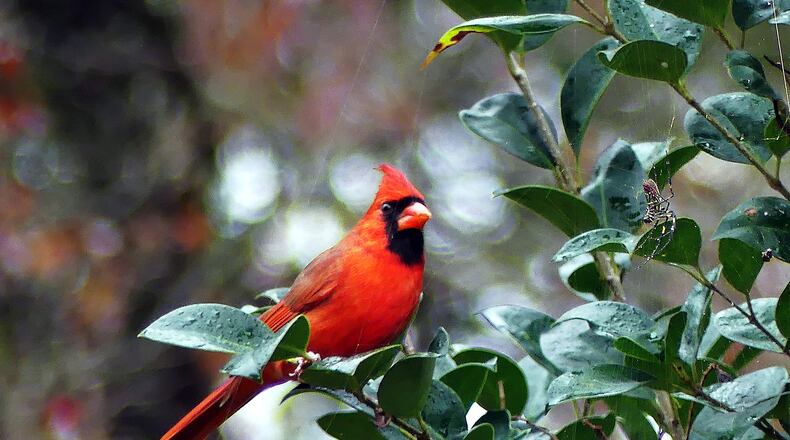When I was walking out my front door in Decatur one morning last weekend, an unusual sight in the yard caught my eye: A bright red male cardinal was trying to hover, hummingbird-style, around an evergreen shrub in an apparent attempt to snatch something there.
Songbirds, of course, can’t hover for more than a few seconds — hummingbirds are the only true hoverers in the bird world. Watching the cardinal’s antics through my binoculars, I thought at first he was trying to reach some pokeberries dangling from a bush next to the shrub.
But a closer look revealed that his efforts at hovering were to peck at something in an orb-weaver spider’s web. And then I saw it: A big, exotic female Joro spider was clinging to the web only a few inches away from the bird.
At first, I thought the bird was trying to snatch the spider. But after a minute, I realized he actually was stealing some small insects and other morsels trapped in her web.
Excited, I thought that maybe I had a scientific first, the first observer of a never-reported-before event in nature — a songbird robbing the web of a Joro spider, the exotic, nonnative arachnid that first showed up in Georgia a few years ago and now seems to be spreading fast in the state.
I envisioned fulfilling a dream — publishing a paper in a scientific journal. I did an internet search to see if anyone else had reported such an event.
Someone had. Arty Schronce, an independent researcher in Atlanta, and Andrew Davis, a University of Georgia biologist, published a paper last year about a cardinal robbing a Joro web.
They also had made an additional observation: The Joro web was so strong that the cardinal actually perched on it while doing his robbing. “The fact that a full-sized northern cardinal could perch on this spider’s web without it breaking appears to be a scientific first,” the authors wrote.
IN THE SKY: From David Dundee, Tellus Science Museum astronomer: The Leonid meteor shower peaks at about 20 meteors per hour this weekend — after dark in the northeastern sky. The moon will be first quarter on Monday. Mercury is low in the west just after sunset. Venus rises in the east a few hours before sunrise. Jupiter rises in the east at sunset and will appear near the moon Friday night (Nov. 24). Saturn is in the south at dusk and will appear near the moon on Monday night.
Charles Seabrook can be reached at charles.seabrook@yahoo.com.
About the Author
Keep Reading
The Latest
Featured


